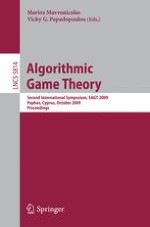This book constitutes the refereed proceedings of the Second International Symposium on Algorithmic Game Theory, SAGT 2009, held in Paphos, Cyprus, in October 2009. The 29 revised full papes presented together with 3 invited lectures were carefully reviewed and selected from 55 submissions. The papers are intended to cover all important areas such as solution concepts, game classes, computation of equilibria and market equilibria, algorithmic mechanism design, automated mechanism design, convergence and learning in games, complexity classes in game theory, algorithmic aspects of fixed-point theorems, mechanisms, incentives and coalitions, cost-sharing algorithms, computational problems in economics, finance, decision theory and pricing, computational social choice, auction algorithms, price of anarchy and its relatives, representations of games and their complexity, economic aspects of distributed computing and the internet, congestion, routing and network design and formation games and game-theoretic approaches to networking problems.
